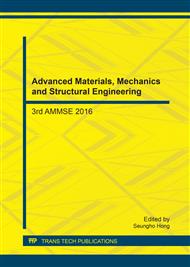p.299
p.305
p.311
p.317
p.323
p.328
p.334
p.345
p.355
An Experimental Study on Effect of T-Joint’s Root Gap on Welding Properties
Abstract:
The aimed of this research is to investigate the effect of T-Joint’s root gap on physical and mechanical properties of weld metal. Low carbon steel were joined in T-joint types using MIG (Metal Inert Gas) with variation of root gap. The root gap used were 0 mm, 3 mm and 6 mm. The physical properties examined with chemical composition, microstructure and corrosion using optical microscope. The mechanical properties were measured with respect to the strength and hardness using Universal testing machine and Vickers Microhardness. The results show that the highest value found in welds with a gap of 3 mm with a value of 163.57 MPa. Hardness value is directly proportional to the tensile strength of the material. The highest value found in welds with root gap of 3 mm, followed by root gap of 6 mm, and 0 mm Hardness values in the welding area is higher than the parent metal and HAZ because the number of Si, Mn and Cu elements in the welding metals are bigger than base metal. Weld with all variation of root gap have a good corrosion resistance because the corrosion rate in welds with various root gap have a value below 0.02 mmpy. Microstructure of weld metals were Accicular ferrite, Widmanstatten ferrite, and grain boundary ferrite, while microstructure of base metal and HAZ were ferrite and perlite.
Info:
Periodical:
Pages:
323-327
Citation:
Online since:
February 2017
Keywords:
Price:
Сopyright:
© 2017 Trans Tech Publications Ltd. All Rights Reserved
Share:
Citation:


